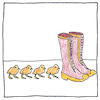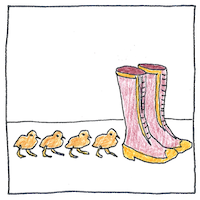Karl von Frisch, Konrad Lorenz, Nikolaas Tinbergen
entomology

|
Instincts
Unintuitively, scientists tended to understand the behavior of animals as though they were like us. Breakthroughs came through objective observation and experimentation. 1. Waggle dancing Von Frisch studied the dancing of honey bees communicating direction and distance to food, water, or shelter. 2. Imprinting Lorenz studied the instincts of geese and jackdaws and rediscovered the way that birds identify with the first moving thing they see as though it were their mother. 3. Supernormal stimuli Tinbergen constructed artificial objects with exaggerated characteristics to stimulate selected instinctual behaviors such as the feeding behaviors of gull chicks.
Anthropomorphism
As humans, we tend to think that all the other animals behave as we do, but it’s more useful to claim that humans behave as other animals.
Animals like us
Animals like us know how to suckle as soon as we are born, and when objects are thrown at our heads we automatically duck. Animals like us yawn involuntarily, cry when we are sad, laugh when tickled, fear the unfamiliar, and desire food and sex. It’s not only when our behavior is selfish, uncontrollable, violent, or irrational that we act like animals.



The opposite extreme from anthropormorphic thinking is thinking that we are not like other animals. In particular, it is wrong to think that humans have no instincts, that all adult behaviors are learned or follow from the exercise of reason and desire, and that desire and instinct have nothing in common.
Scientists claim that when babies use the same phonemes to mean different things they are expressing a language instinct that distinguishes humans from other primates. In my opinion, this, too, will eventually be considered anthropocentric.
See also in The book of science:
Readings in wikipedia:
Other readings: